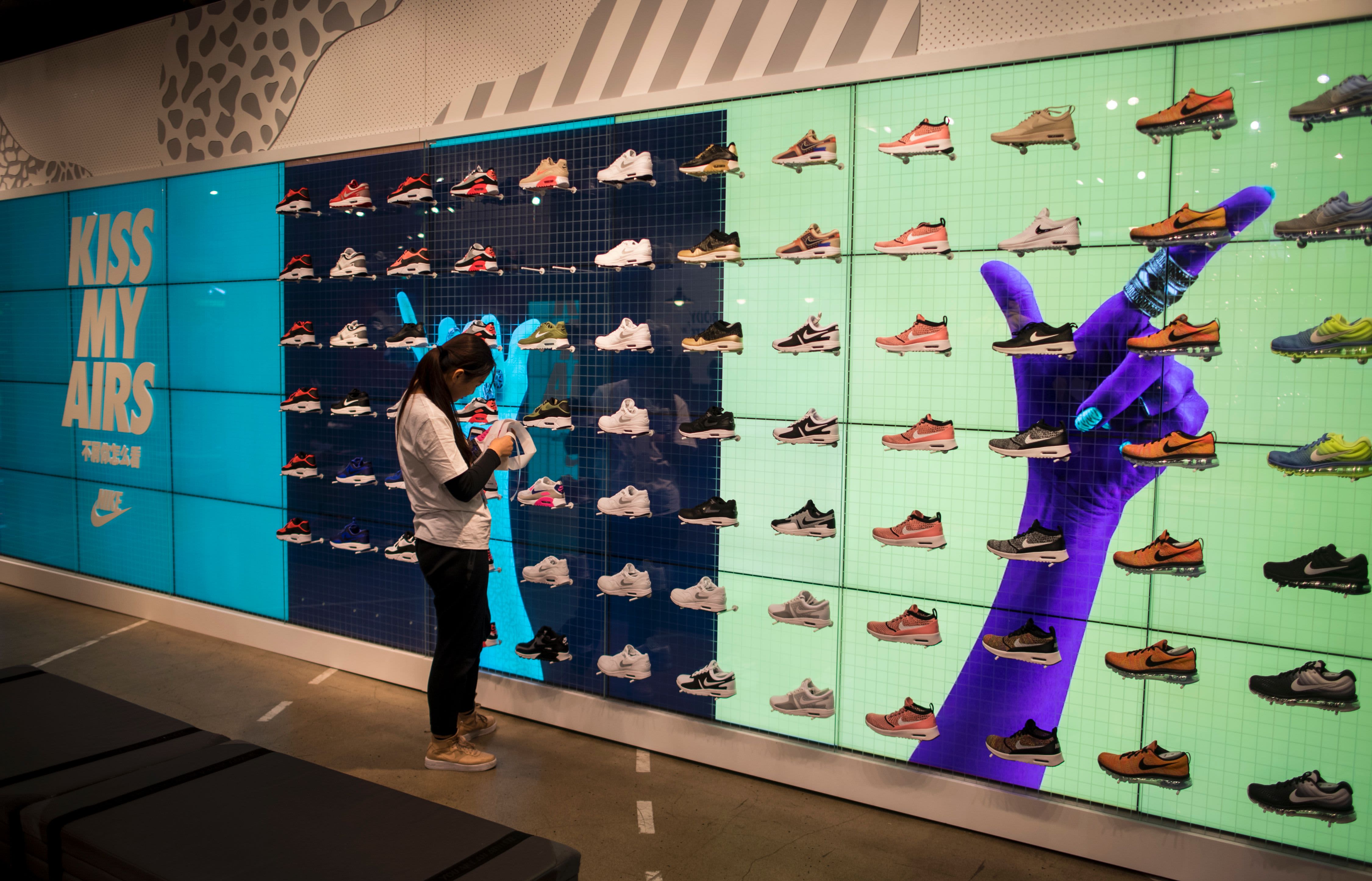An employee works next to shoes on display inside the flagship store of sporting-goods giant Nike in Shanghai on March 16, 2017.
Johannes Eisele | AFP | Getty Images
American companies in China are still betting on the local consumer, even if business disruptions from the coronavirus are dragging down revenues.
A survey of 119 companies from March 13 to 18 by the Beijing-based American Chamber of Commerce in China found that the proportion of respondents saying they are experiencing significant revenue declines increased to 50% — that’s up from 28% last month.
“The consumer sector as we see in this survey has been particularly hard hit,” Alan Beebe, AmCham China president, said on a call with reporters Wednesday morning. “(It’s) the sector that had one of the largest revenue disruptions.”
“On the other hand, it’s the sector, along with technology, where investment plans really haven’t changed,” he said. “The way I interpret that is, while they’re taking a hit short term, there’s no fundamental change in outlook.”
Officially called COVID-19, the highly contagious disease that emerged in late December in the Chinese city of Wuhan, has spread rapidly across the globe in the last few weeks. As of Wednesday, the virus has killed more than 16,000 people worldwide, with China accounting for over 3,200 of those deaths. Governments in countries from Italy to the United States have called for people to stay at home and for non-essential businesses to close.
The shutdowns have spurred fears of a global recession, sending financial markets worldwide churning.
Operating earnings per share for the S&P 500 are expected to grow just 0.2% this year, with that of consumer discretionary falling 1.3%, according to a March 20 note from Sam Stovall, chief investment strategist at CFRA.
Many companies, especially those in the consumer discretionary sector — which provide nonessential goods and services such as cars, apparel and entertainment — have mentioned “coronavirus” or “COVID-19” on their quarterly earnings calls, according to analysis from FactSet, published March 20.
The report by Senior Earnings Analyst John Butters said that for the 213 companies in the S&P 500 that discussed those two terms, their average revenue exposure to China is 6%.
When the coronavirus first broke out in China, businesses were most concerned about disruptions to global supply chains and growth in the world’s second-largest economy. The acceleration of the outbreak overseas has shifted worries to global growth, even as China and its hundreds of millions of consumers get back to work.
“Now that we’re in a global pandemic situation, demand for our member companies’ products and services has changed significantly, somewhat for reasons of supply chain, but others, really just consumer demand,” Greg Gilligan, AmCham chairman, said on CNBC’s “Squawk Box Asia” Wednesday.
He said members are planning to cut costs, revise budgets and change projections for the year, but have not yet adjusted or reduced staff.
An increased proportion of respondents in March said demand for their products fell — 39% of firms versus 22% in February.
On the supply chain side, AmCham members were less affected by the relatively slower resumption of work for small and medium-sized firms. The survey found that nearly two-thirds of respondents said these smaller businesses accounted for no more than a quarter of their supply chain, while only 11% have a strong reliance.
Consumer businesses still planning to invest
The chamber’s annual business conditions survey late last year found the consumer sector was one of the industries more optimistic about their market opportunity in China for 2020, given the country’s large and growing middle class.
In last week’s flash survey of members, the consumer, as well as resources and industrial industries, were the most pessimistic about the virus’ impact on market growth this year, with 38% of firms in both industries expecting a decrease of at least 50%.
But the consumer sector had the highest proportion of businesses saying they would maintain previously planned investments — at 46%, while 8% said they would increase planned investments, the survey found.
The services sector was the only other industry to report businesses planning to increase investments, also at 8%, while the technology industry had the second-highest proportion of businesses maintaining investments — at 43%.
Foreign direct investment in China plunged 25.6% in February, bringing the total for the first two months of the year to 134.4 billion yuan ($19.2 billion), a decline of 8.6% year-over-year in yuan terms, according to China’s Ministry of Commerce.
For AmCham members overall, 40% said in the latest survey they would maintain previously planned levels of investment, up from 23% last month. Only 2% said they would consider exiting the Chinese market in the next three to five years, the March survey found.
“This indicates both patience and confidence that eventually business will return back to normal in China and this wouldn’t lead to any abrupt changes in long term strategy,” Beebe said.
Slightly more than a fifth of respondents are already back at work, with 13% expecting to resume normal operations by the end of this month, and 23% by the end of April, the survey found.
When it comes to government support, the top ask is tax alleviation, followed by consistency of policy and travel restrictions across different regions of China, according to the survey.
Based on the survey results, AmCham’s chairman Gilligan was also optimistic that pressure from the coronavirus would give China further impetus to follow through on reforms to the business environment.
